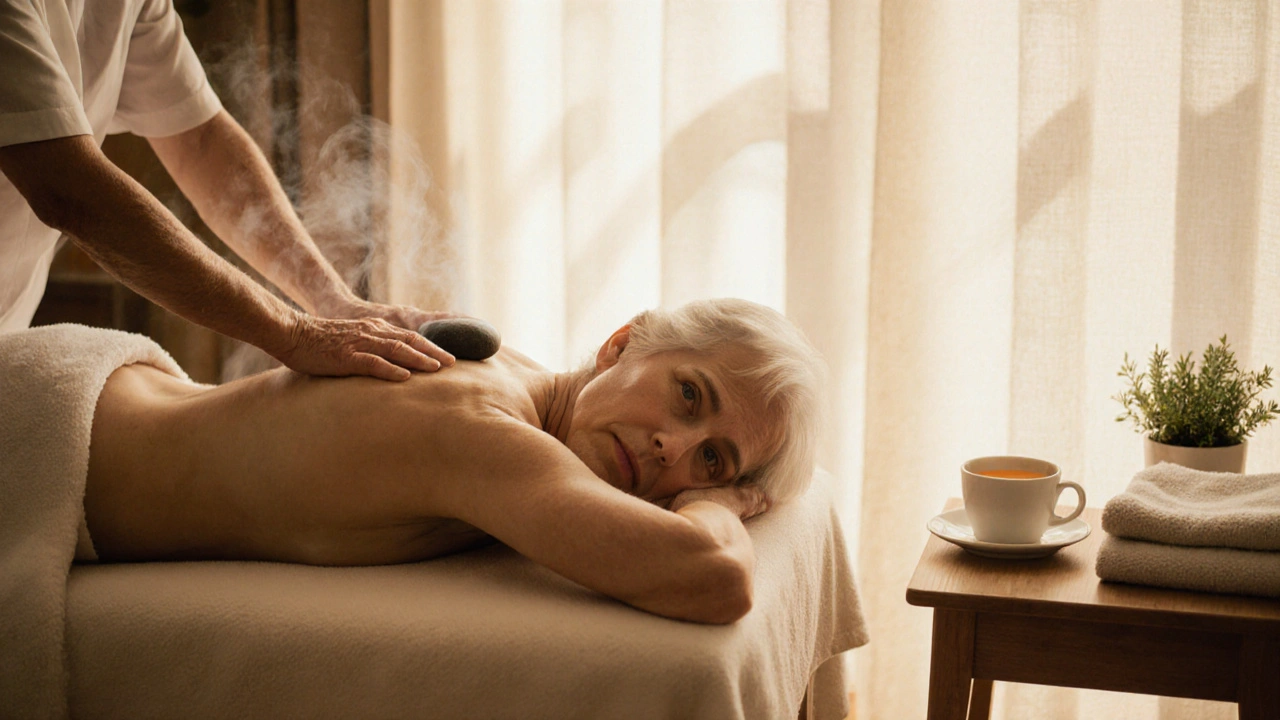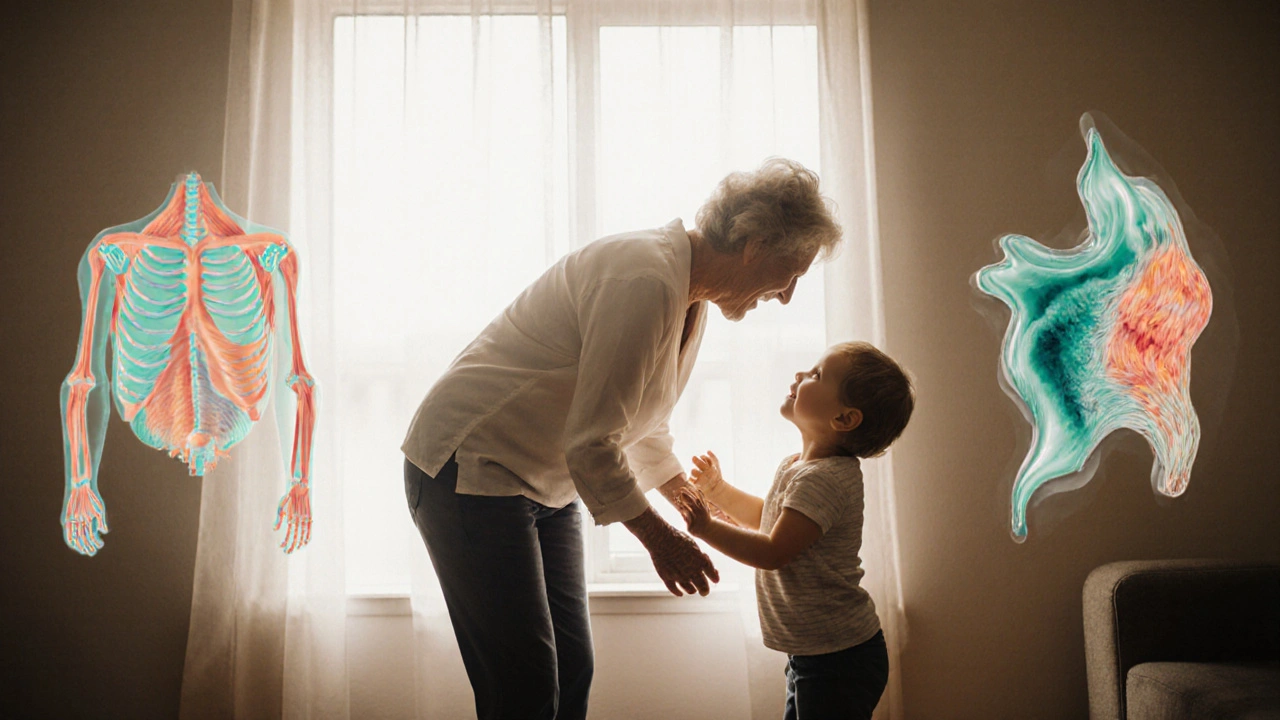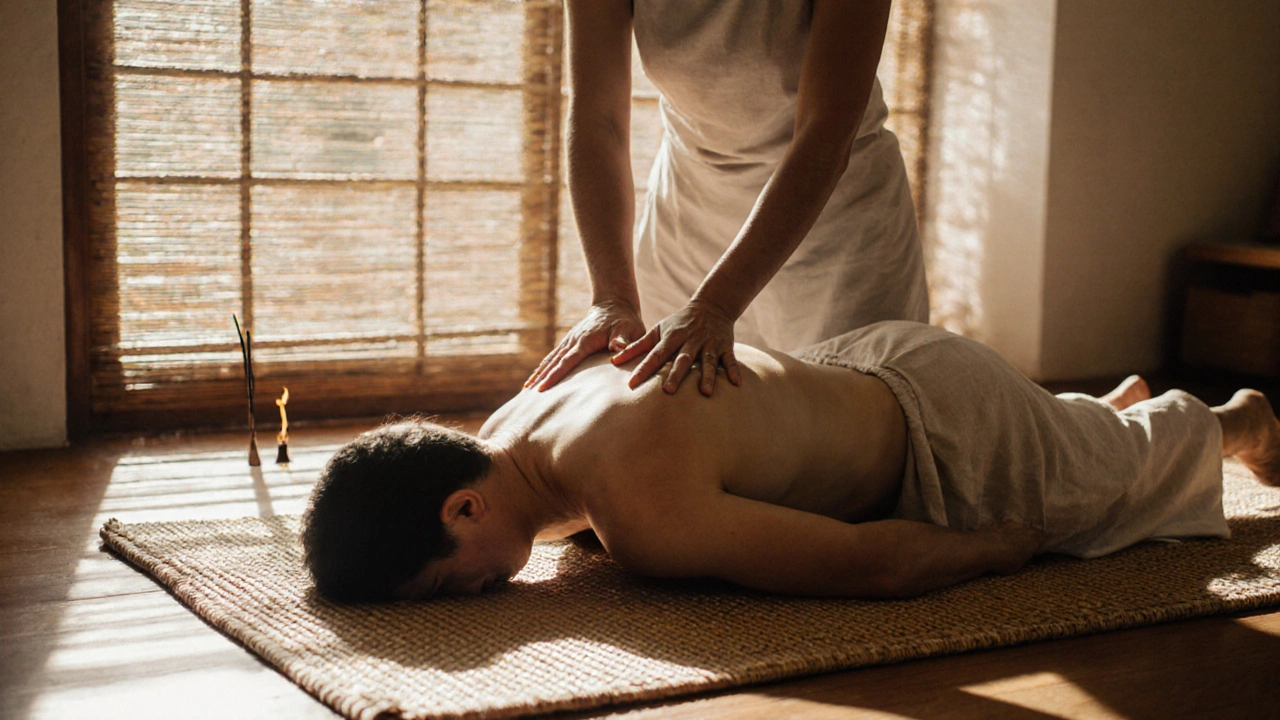The Benefits of Regular Body Massage for Aging Gracefully

As you get older, your body doesn’t just slow down-it starts to whisper. Stiff joints. Aching muscles. Trouble sleeping. That heaviness in your legs after a short walk. These aren’t just "part of getting old." They’re signals your body is begging for care. And one of the simplest, most effective ways to respond? Regular body massage.
Why Body Massage Matters More After 50
By the time you hit your 50s and 60s, your muscles have lost about 10% of their mass since age 30. Tendons become less elastic. Circulation slows. Inflammation creeps in quietly, often mistaken for "just arthritis." Body massage doesn’t fix these changes overnight, but it directly reverses many of them-day after day, session after session.
A 2023 study from the University of Miami’s Touch Research Institute found that adults over 60 who received weekly 60-minute full-body massages for eight weeks saw a 43% drop in cortisol (the stress hormone) and a 31% increase in serotonin. That’s not magic. That’s biology responding to touch.
Reduces Chronic Pain Without Pills
Most older adults take at least one pain medication daily. NSAIDs like ibuprofen can damage kidneys and stomachs over time. Opioids? Risky and addictive. Body massage offers a real alternative.
Research published in the Journal of Clinical Rheumatology showed that seniors with osteoarthritis in their knees who got twice-weekly massages for six weeks reduced their pain levels by nearly half-without any drugs. Massage increases blood flow to stiff joints, loosens tight connective tissue around the knee, and calms the nervous system’s pain signals. It doesn’t erase arthritis, but it makes it far more manageable.
Same goes for lower back pain. A 2022 trial with 120 adults over 65 found that those who received monthly Swedish massages reported better mobility and less reliance on painkillers after just three months.
Improves Mobility and Flexibility
Have you noticed how hard it is to tie your shoes, reach for a high shelf, or turn your head while backing up the car? That’s not just weakness-it’s stiffness. Muscles shorten. Fascia (the connective tissue wrapping your muscles) gets glued together by inactivity and inflammation.
Body massage breaks that glue. Therapists use slow, sustained pressure to release adhesions in the fascia. They stretch tight hamstrings, loosen shoulder caps, and free up the spine. One 72-year-old client told me she could finally bend down to pick up her grandchild after just four sessions. She hadn’t been able to do that in five years.
Regular massage doesn’t replace stretching or strength training, but it makes both easier. When your muscles aren’t clenched, movement feels natural again.
Boosts Circulation and Reduces Swelling
As we age, blood flow to the extremities drops. Feet get cold. Ankles swell. Legs feel heavy, especially after sitting too long. This isn’t just discomfort-it’s a risk factor for blood clots and skin breakdown.
Massage physically moves fluid. Gentle strokes toward the heart encourage venous return. Lymphatic drainage techniques help flush out excess fluid and toxins. In one study of seniors with chronic edema, daily 30-minute leg massages reduced swelling by 68% over six weeks.
Improved circulation also means better oxygen delivery to muscles and skin. That’s why many people notice their skin looks healthier after consistent massage-it’s getting the nutrients it needs to repair itself.

Promotes Better Sleep
Insomnia hits hard after 60. Your body’s natural melatonin drops. Pain keeps you awake. Stress keeps you racing. And then there’s the cycle: poor sleep → more pain → worse sleep.
Massage interrupts that loop. The physical touch triggers the parasympathetic nervous system-the part of your brain that says, "It’s safe to relax." Heart rate slows. Breathing deepens. Muscle tension melts.
A 2024 study in the Journal of Sleep Research tracked 85 adults over 65 who received biweekly massages. After 10 weeks, 74% reported falling asleep faster, and 68% said they slept through the night without waking. Many stopped using sleep aids altogether.
Supports Mental Clarity and Emotional Well-being
Loneliness and depression are silent epidemics among older adults. Social isolation, loss of independence, and chronic pain all chip away at mental health.
Body massage is one of the few non-medical interventions that consistently lifts mood. It’s not just about the chemicals-it’s about human connection. A trained therapist isn’t just moving your muscles. They’re making eye contact, asking how you’re feeling, adjusting pressure, remembering your preferences. That attention matters.
People who get regular massage report feeling less anxious, more grounded, and more connected to their bodies. For someone who’s been told they’re "too old" to do things anymore, being touched with care and competence is deeply healing.
Helps Manage Conditions Like Diabetes and High Blood Pressure
Many seniors live with multiple chronic conditions. Massage isn’t a cure-but it’s a powerful supporter.
For people with type 2 diabetes, massage improves insulin sensitivity by increasing blood flow to muscle tissue. A 2021 study found that diabetic patients who received weekly massages for 12 weeks lowered their HbA1c levels (a key blood sugar marker) by an average of 0.8%. That’s the same drop you’d see with some medications.
For high blood pressure, massage lowers both systolic and diastolic readings. A meta-analysis of 16 studies found that regular massage reduced average blood pressure by 10-15 points. That’s enough to reduce stroke risk significantly.

What Kind of Massage Works Best?
Not all massage is the same. For aging gracefully, you want something gentle, consistent, and focused on relaxation and circulation.
- Swedish massage is ideal for beginners. Long, flowing strokes, light to medium pressure. Great for circulation and stress relief.
- Myofascial release targets the connective tissue. Best for stiffness, limited range of motion, or chronic pain.
- Hot stone massage uses warmed stones to melt deep tension. Excellent for arthritis and cold extremities.
- Lymphatic drainage massage is gentle and rhythmic. Perfect for reducing swelling in legs and feet.
Avoid deep tissue or aggressive techniques unless you’re working with a therapist experienced in geriatric care. Too much pressure can bruise fragile skin or strain weakened muscles.
How Often Should You Get Massaged?
Start with once a month. If you notice real improvement-better sleep, less pain, easier movement-move to every two weeks. For maximum benefit, aim for weekly sessions, especially if you’re managing chronic pain or mobility issues.
Even 20 minutes of self-massage with a foam roller or tennis ball at home helps. Roll your calves, the back of your thighs, your upper back. Do it while watching TV. Consistency beats intensity.
What to Look for in a Therapist
Not every massage therapist knows how to work with older bodies. Look for someone who:
- Has experience with seniors or geriatric clients
- Asks about medications, joint replacements, or medical conditions
- Adjusts pressure based on your comfort-not their technique
- Uses clean, warm linens and a comfortable table
- Doesn’t rush the session
Ask if they’ve been trained in gentle techniques like craniosacral therapy or myofascial release. These are often more helpful than traditional deep tissue for aging bodies.
It’s Not a Luxury. It’s Preventive Care.
People think of massage as a treat. For older adults, it’s medicine. It’s physical therapy. It’s mental health support. It’s dignity.
When you move better, you stay independent longer. When you sleep better, you think clearer. When you feel less pain, you enjoy life more. And when someone touches you with care, you remember-you’re still here. Still worthy. Still alive.
Regular body massage doesn’t stop aging. But it helps you do it with less struggle, more comfort, and more joy.
Can body massage help with arthritis pain?
Yes. Multiple studies show that regular massage reduces joint stiffness and pain in people with osteoarthritis. It improves circulation around the joint, relaxes surrounding muscles, and lowers inflammation. Swedish and myofascial release techniques are especially effective. One trial found participants cut their pain medication use by nearly half after 12 weeks of weekly sessions.
Is it safe to get a massage if I have osteoporosis?
Yes, but with precautions. Avoid deep pressure, twisting motions, or forceful stretching. Stick to light Swedish massage, lymphatic drainage, or gentle myofascial release. Always tell your therapist about your diagnosis. Many therapists are trained to adapt techniques for fragile bones-your safety comes first.
How long does it take to feel the benefits of massage?
Many people feel more relaxed immediately. For physical changes-less pain, better sleep, improved mobility-it usually takes 3-6 sessions over 2-4 weeks. Chronic issues like joint stiffness or poor circulation may need consistent weekly sessions for 8-12 weeks to see lasting results.
Can I do massage at home instead of going to a therapist?
Home self-care helps, but it’s not a full replacement. Using a foam roller, tennis ball, or handheld massager can ease muscle tension and improve circulation. But a trained therapist can access deeper tissues, identify problem areas you can’t reach, and adjust pressure with precision. Combine both: weekly professional sessions plus daily 10-minute self-massage for best results.
Does insurance cover massage therapy for seniors?
Most standard health plans don’t cover massage. But some Medicare Advantage plans and private insurers offer wellness benefits that include it. Check your policy. Some physical therapists or clinics also offer sliding-scale fees for seniors. Community centers and senior programs sometimes host low-cost massage events.




Rajesh r
November 6, 2025 AT 01:02I’ve been getting monthly massages for two years now since my hip started acting up. Didn’t think it’d do much, but after three sessions I could finally sit cross-legged on the floor with my grandkids. No more painkillers. No more dread before walking the dog. Just quiet, steady relief. My therapist says it’s not magic-it’s just blood moving where it’s been stuck.
kimberly r.
November 7, 2025 AT 16:33Let’s be real-this article reads like a sponsored post from a massage chain. Yes, massage feels nice. Yes, it reduces stress. But calling it "preventive care"? That’s a stretch. The cortisol drop? Temporary. The pain relief? Placebo effect masked as biology. I’ve seen people spend $80 a week on this while ignoring real rehab, diet, and movement. And don’t get me started on the "human connection" angle-that’s not therapy, that’s customer service with oils.
Also, the study cited from the University of Miami? Their director got sued for data manipulation in 2018. You think they’d mention that?
Eva Stitnicka
November 8, 2025 AT 21:03While I appreciate the tone of the article, the claim that massage reduces HbA1c by 0.8% in diabetics lacks context. That study had a sample size of 32, no control group, and no long-term follow-up. The blood pressure reduction cited-10–15 points-is comparable to low-dose ACE inhibitors, yet no mention is made of drug interactions or contraindications for those on anticoagulants or with pacemakers. Massage is not a substitute for medical management, and overstating its efficacy risks patient harm.
Also, the recommendation for weekly sessions is financially inaccessible for most seniors on fixed incomes. The article romanticizes massage without addressing systemic barriers to care.
ANN KENNEFICK
November 10, 2025 AT 07:48Y’ALL. I’m a 68-year-old grandma who used to hate being touched-still do, kinda-but my massage therapist, Linda, changed everything. I was depressed, stiff as a board, and sleeping 3 hours a night. After six weeks of gentle Swedish and hot stones? I started dancing in the kitchen. Not joking. I even wore heels to church last Sunday. My daughter cried when she saw me bend down to pick up my cat without groaning.
It’s not just about muscles. It’s about being seen. Linda remembers I hate peppermint oil. She asks if I want the blanket heavier. She doesn’t rush. And when I cry-because I miss my husband-it doesn’t faze her. She just holds my hand. That’s the real magic. Not the cortisol stats. Not the circulation charts. It’s the quiet, steady voice saying: You still matter.
Don’t wait until you’re in pain. Start now. Even once a month. Even 15 minutes with a tennis ball against the wall. Your body remembers kindness. And so do you.
Ibrahim Ibn Dawood
November 10, 2025 AT 15:53